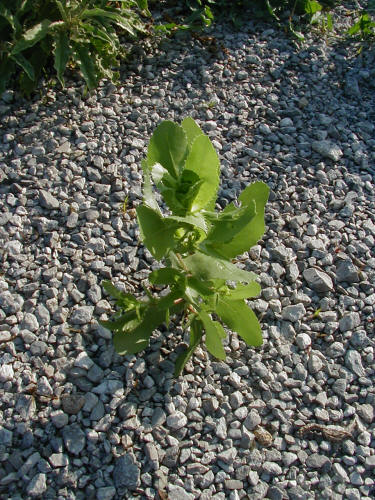Curlycup Gumweed
Curlycup Gumweed
Grindelia squarrosa (Pursh) Dunal
Asteraceae (Sunflower Family)

▲ young plant
▲ plant initiating flowering
▲ ▼ inflorescence buds, showing downward curled bracts below the head
▲ ▼ mature, flowering plants

▲ ▼ mature, flowering plants
▲ ▼ flowers and buds showing curly bracts on base of head inflorescence (below)

▲ ▼ flowers/inflorescences
▲ ▼ stems and leaves
Grindelia squarrosa (Pursh) Dunal, Curlycup Gumweed, Rosinweed, Gumweed: (Bayer Code: GRNSQ; US Code GRSQ)
- A U.S. native annual, biennial or short-lived perennial with ridged-round, light-green to yellow-green or yellow-brown stems that grow 9-36 inches tall, often much-branched in upper 2/3 to 1/2 of plant
- Leaves are thick-textured, alternate oval-lanceolate, with toothed margins and round-pointed tip; leaf bases clasp around stem; resin glands dot leaf and are at the tips of teeth along leaf margins
- Head inflorescences are at stem tips, 1-2 inches diameter, with 20-40 yellow ray flowers (“petals") and many yellow disk flowers
- Bracts below the inflorescence give the plant its common name--they are bright green, lanceolate to linear, in several overlapping rows, and the tips of the bracts curl away and down from the base of the inflorescence (= “curlycup"), and they are coated with resin dots (= “gumweed")
- Flowers mid-summer through early-autumn
- Found in dry, disturbed soil, fields, pastures, prairies, rangeland, right-of-ways, non-cropland
- Can accumulate selenium in high-selenium soils, leading to selenium toxicity, if grazed; is generally not palatable to livestock due to resins and other chemicals in plant
- Can distinguish from similar Waxleaf Goldenweed (Grindelia ciliata) by the more flattened, lanceolate to triangular outspread bracts below the inflorescence on waxleaf goldenweed, and the fewer resin glands on the leaves and bracts of the plant; also the leaf teeth have more hair-like extensions on waxleaf goldenweed